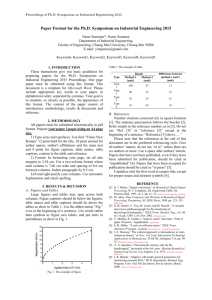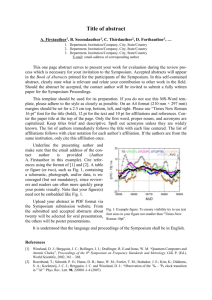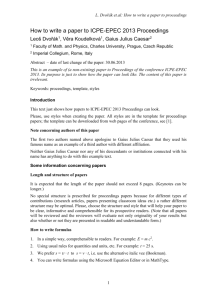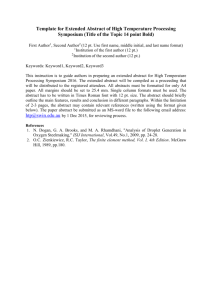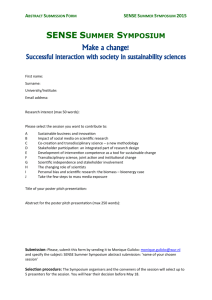Combustion Symposium Paper Template: Formatting Guide
advertisement
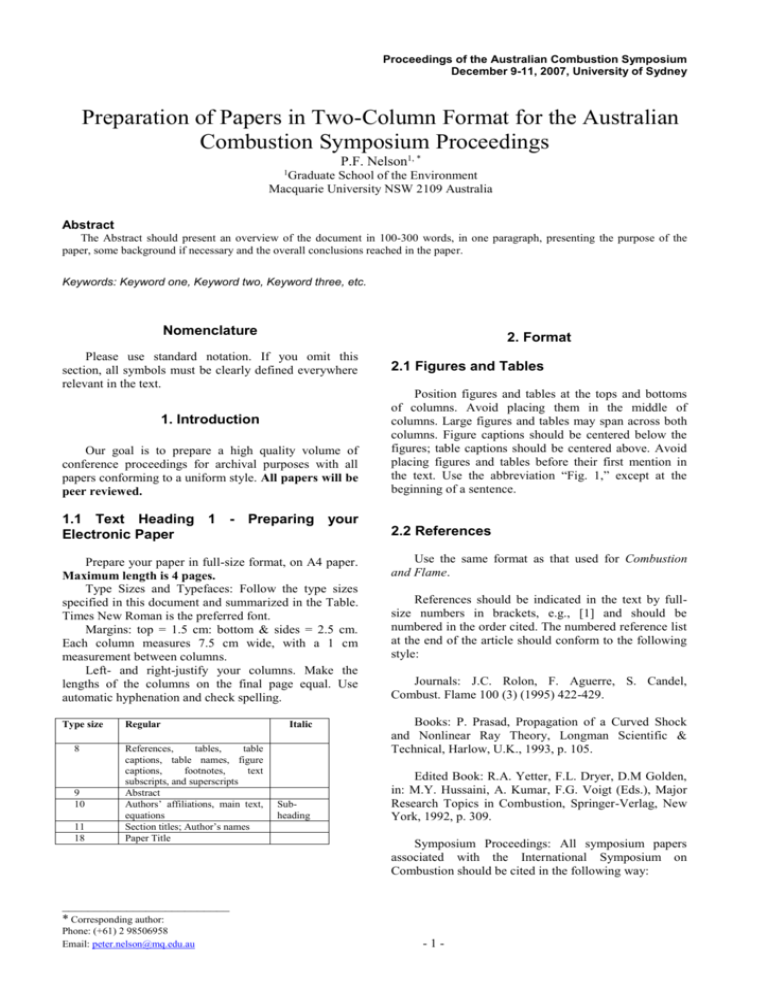
Proceedings of the Australian Combustion Symposium December 9-11, 2007, University of Sydney Preparation of Papers in Two-Column Format for the Australian Combustion Symposium Proceedings P.F. Nelson1, * 1 Graduate School of the Environment Macquarie University NSW 2109 Australia Abstract The Abstract should present an overview of the document in 100-300 words, in one paragraph, presenting the purpose of the paper, some background if necessary and the overall conclusions reached in the paper. Keywords: Keyword one, Keyword two, Keyword three, etc. Nomenclature 2. Format Please use standard notation. If you omit this section, all symbols must be clearly defined everywhere relevant in the text. 2.1 Figures and Tables Our goal is to prepare a high quality volume of conference proceedings for archival purposes with all papers conforming to a uniform style. All papers will be peer reviewed. Position figures and tables at the tops and bottoms of columns. Avoid placing them in the middle of columns. Large figures and tables may span across both columns. Figure captions should be centered below the figures; table captions should be centered above. Avoid placing figures and tables before their first mention in the text. Use the abbreviation “Fig. 1,” except at the beginning of a sentence. 1.1 Text Heading 1 - Preparing your Electronic Paper 2.2 References 1. Introduction Prepare your paper in full-size format, on A4 paper. Maximum length is 4 pages. Type Sizes and Typefaces: Follow the type sizes specified in this document and summarized in the Table. Times New Roman is the preferred font. Margins: top = 1.5 cm: bottom & sides = 2.5 cm. Each column measures 7.5 cm wide, with a 1 cm measurement between columns. Left- and right-justify your columns. Make the lengths of the columns on the final page equal. Use automatic hyphenation and check spelling. Use the same format as that used for Combustion and Flame. Type size Books: P. Prasad, Propagation of a Curved Shock and Nonlinear Ray Theory, Longman Scientific & Technical, Harlow, U.K., 1993, p. 105. 8 9 10 11 18 Regular References, tables, table captions, table names, figure captions, footnotes, text subscripts, and superscripts Abstract Authors’ affiliations, main text, equations Section titles; Author’s names Paper Title Italic Subheading References should be indicated in the text by fullsize numbers in brackets, e.g., [1] and should be numbered in the order cited. The numbered reference list at the end of the article should conform to the following style: Journals: J.C. Rolon, F. Aguerre, S. Candel, Combust. Flame 100 (3) (1995) 422-429. Edited Book: R.A. Yetter, F.L. Dryer, D.M Golden, in: M.Y. Hussaini, A. Kumar, F.G. Voigt (Eds.), Major Research Topics in Combustion, Springer-Verlag, New York, 1992, p. 309. Symposium Proceedings: All symposium papers associated with the International Symposium on Combustion should be cited in the following way: __________________________ * Corresponding author: Phone: (+61) 2 98506958 Email: peter.nelson@mq.edu.au -1- R.S. Cant, S.B. Pope, K.N.C. Bray, Proc. Combust. Inst. 23 (1990) 809-815. Conference Proceedings: A conference proceedings should be styled as a book, with publisher or institution sponsoring publication and the year published as well as the year the conference was held. Internal Reports: A.S. Johnson, F.W. Adams, Use of Laser Diagnostics in Supersonic Flows, Report No. SAND87-8003, Sandia National Laboratories, 1987. Authors must ensure that these references are publicly available. Combustion Symposium. All papers should be submitted electronically in PDF format. After revision (if required) and acceptance papers should be submitted in both PDF and Word formats We are looking forward to seeing you in Sydney in December. 4. Acknowledgments Put acknowledgments here. 5. References 2.3 Abbreviations and Acronyms Define abbreviations and acronyms the first time they are used in the text, even if they have been defined in the abstract. 2.4 Equations Number equations consecutively with equation numbers in parentheses flush with the right margin, as in (1). Symbols in your equation should be defined before the equation appears or immediately following. Use “(1),” not “Eq. (1)” or “equation (1),” except at the beginning of a sentence. 2.5 Page Numbering Each paper will be assigned a number in the conference proceedings. To facilitate printing and further referencing, local page numbering is used in each paper, starting from page 1. The page number should appear centered as footer. 3. Conclusion and Submission Instructions This template is designed to assist you in the preparation of your manuscript for the Australian -2- List references in format specified above. For example: [1] H.L. MacLean and L.B. Lave, Prog. Energy Combust. Sci. 29 (1) (2003), pp. 1–69 [2] B.-Q. He, S.-J. Shuai, J.-X. Wang and H. He, Atmos. Environ. 37 (35) (2003), pp. 4965–4971. [3] S.G. Poulopoulos, D.P. Samaras and C.J. Philippopoulos, Atmos. Environ. 35 (26) (2001), pp. 4399– 4406. [4] T. Murayama, N. Miyamoto, T. Chikahisa, H. Ogawa, SAE Technical Paper No. 830373, 1983. [5] N.D. Brinkman, SAE Special Publication SP-480, 1983, pp. 83–97. [6] R.D. Zhang, H. He, X.Y. Shi, C.B. Zhang, B.Q. He and J.X. Wang, J. Environ. Sci. (China) 16 (5) (2004), pp. 793– 796. [7] X. Lü, Z. Huang, W. Zhang and D. Li, Combust. Sci. Technol. 176 (8) (2004), pp. 1309–1329. [8] S.R. Smith and A.S. Gordon, J. Phys. Chem. 60 (8) (1956), pp. 1059–1062. [9] T.P. Pandya and N.K. Srivastava, Combust. Sci. Technol. 11 (5–6) (1975), pp. 165–180. [10] P. Andreussi and L. Petarca, Proc. Combust. Inst. 18 (1981), pp. 1861–1869.
